UP CLOSE with NATURE







FOLDER 1: A PITCHER BRISTLING WITH MYSTERY
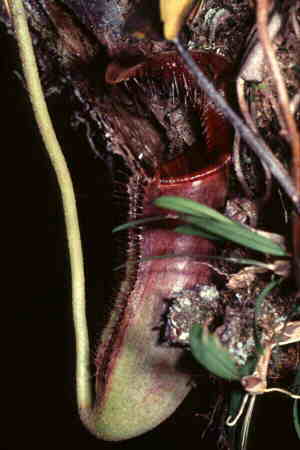
|

|
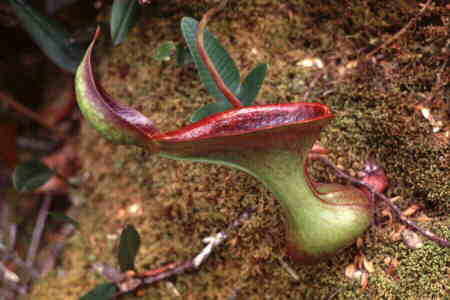
|
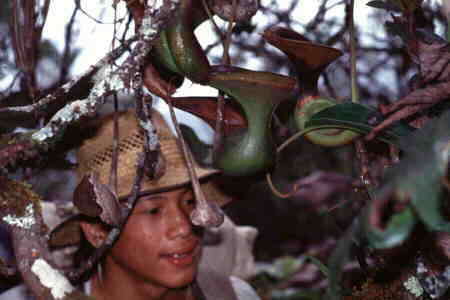
|
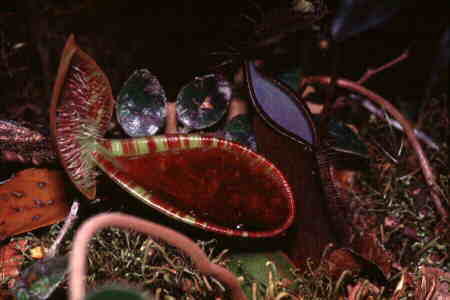
|
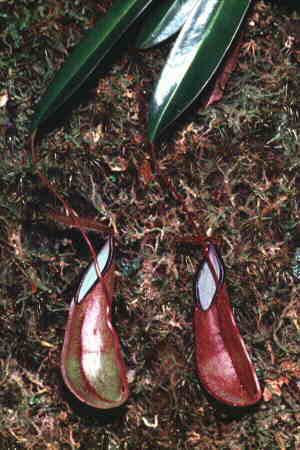
|
CLICK ON A THUMBNAIL IMAGE TO VIEW THE LARGER PHOTO. MORE THUMBNAILS BELOW.
A pitcher bristling with mystery
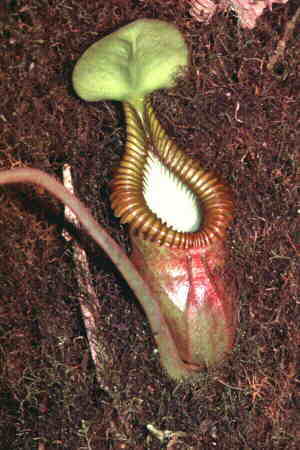 WHILE searching the Gunung Trusmadi summit
ridge on 12 March 1990 for Nepenthes x trusmadiensis, the natural hybrid between
Nepenthes lowii and Nepenthes edwardsiana, I found a pitcher, roughly three
inches high, with bristles on the undersurface of its lid.
WHILE searching the Gunung Trusmadi summit
ridge on 12 March 1990 for Nepenthes x trusmadiensis, the natural hybrid between
Nepenthes lowii and Nepenthes edwardsiana, I found a pitcher, roughly three
inches high, with bristles on the undersurface of its lid.
Here are two photographs of the pitcher (above and top right), a frontal view and a side view. I did not take any specimens but I noted that the pitcher was hanging down and leaning against a tree trunk among some detritus and epiphytic orchids.
There was another pitcher on the same plant but this was too high up for me to photograph. The plant itself was small and apparently epiphytic as it grew among some detritus lodged in the crook of a branch.
Later, I learned that Nepenthes lowii is the only species of pitcher plant in Sabah that has bristles under the lid. Curious about the identity of the pitcher I have photographed, I sought the help of a botanist and he suggested that it could be a natural hybrid, with N. lowii and perhaps N. tentaculata (which is also found on the mountain, but more common at the lower elevations) as the parents.
Since then, I have come across an article “Pitcher Plants of East Malaysia and Brunei” jointly authored by A. Phillips and A. Lamb in Nature Malaysiana (Vol. 13 No. 4, October 1988). The article is illustrated with many colour photographs. One of these shows the lower pitcher of N. lowii. Its cylindrical form, with only a slight bulge in the lower half, differs quite dramatically from the gourd-like shape of the aerial pitchers.
Also, it has an abundance of bristles on the undersurface of the lid compared to the pitcher shown here (whose bristles look sparse by comparison) and was reddish in colour instead of green and brown.
Our “mystery” pitcher may well be the lower or ground pitcher of N. lowii, but is it?
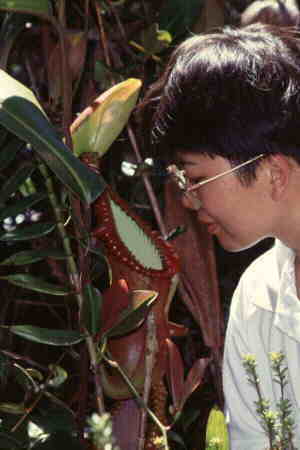 Another botanist (who has access to both herbarium material and living
specimens) is also of the opinion that it could be a hybrid. If it is a hybrid, he says, the
most probably parents could be N. lowii (apparent) and N. edwardsiana (uncertain).
These latter two species are abundant on Gunung Trusmadi.
Another botanist (who has access to both herbarium material and living
specimens) is also of the opinion that it could be a hybrid. If it is a hybrid, he says, the
most probably parents could be N. lowii (apparent) and N. edwardsiana (uncertain).
These latter two species are abundant on Gunung Trusmadi.
If after all it is another hybrid between these two famous parents, it is somewhat a disappointment compared to the magnificent N. x trusmadiensis, who cylindrical pitchers can attain a length of over 19 inches (see Malayan Naturalist, Vol. 38 No. 2) and, unlike N. lowii, have no bristles.
In any case, I would be happy if anyone can shed some light on the identity of this pitcher which, by itself, is not such a bad-looking specimen... even with bristles.
This article received a response from none other than Johannes Marabini, the man who discovered Nepenthes x trusmadiensis on Gunung Trusmadi, and he was very certain that our “mystery” pitcher is Nepenthes lowii.
In his letter, published in Vol. 45 Nos 1 & 2, Marabini said: “The plant which you show on page 35 is a lower pitcher of a juvenile plant of Nepenthes lowii. You can recognize it by the long bristles under the lid. Nepenthes x trusmadiensis has no or only a few bristles.”
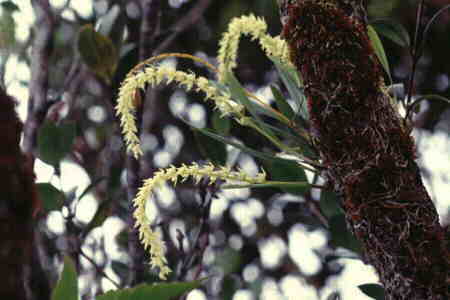 Marabini said he climbed Gunung Trusmadi again in March 1991, this time
accompanied by two German botanists, and saw Nepenthes x trusmadiensis again. He discovered
a new location with a few huge plants of the natural hybrid and some seedlings along the ridge
from Ulu Monsuk. He added: “We saw a lot of N. lowii and N. edwardsiana ssp.
macrophylla growing and flowering together but only a few seedlings of N. x trusmadiensis.
And we saw fruits of N. x trusmadiensis.”
Marabini said he climbed Gunung Trusmadi again in March 1991, this time
accompanied by two German botanists, and saw Nepenthes x trusmadiensis again. He discovered
a new location with a few huge plants of the natural hybrid and some seedlings along the ridge
from Ulu Monsuk. He added: “We saw a lot of N. lowii and N. edwardsiana ssp.
macrophylla growing and flowering together but only a few seedlings of N. x trusmadiensis.
And we saw fruits of N. x trusmadiensis.”
Marabini mentioned something else of interest. “Very interesting was that we could measure -1° C at one night on the second summit. We had ice pearls on our tents,” he wrote. I recalled that both my tent-mate and I were awakened by water condensation dripping onto our face. Night temperatures on Gunung Trusmadi, I understand, typically fall to 5° C. So, Marabini and his companions must have experienced one of those unusually cold nights on Gunung Trusmadi.

This page revised on 21 March 2003. Copyright © Chin Fah Shin